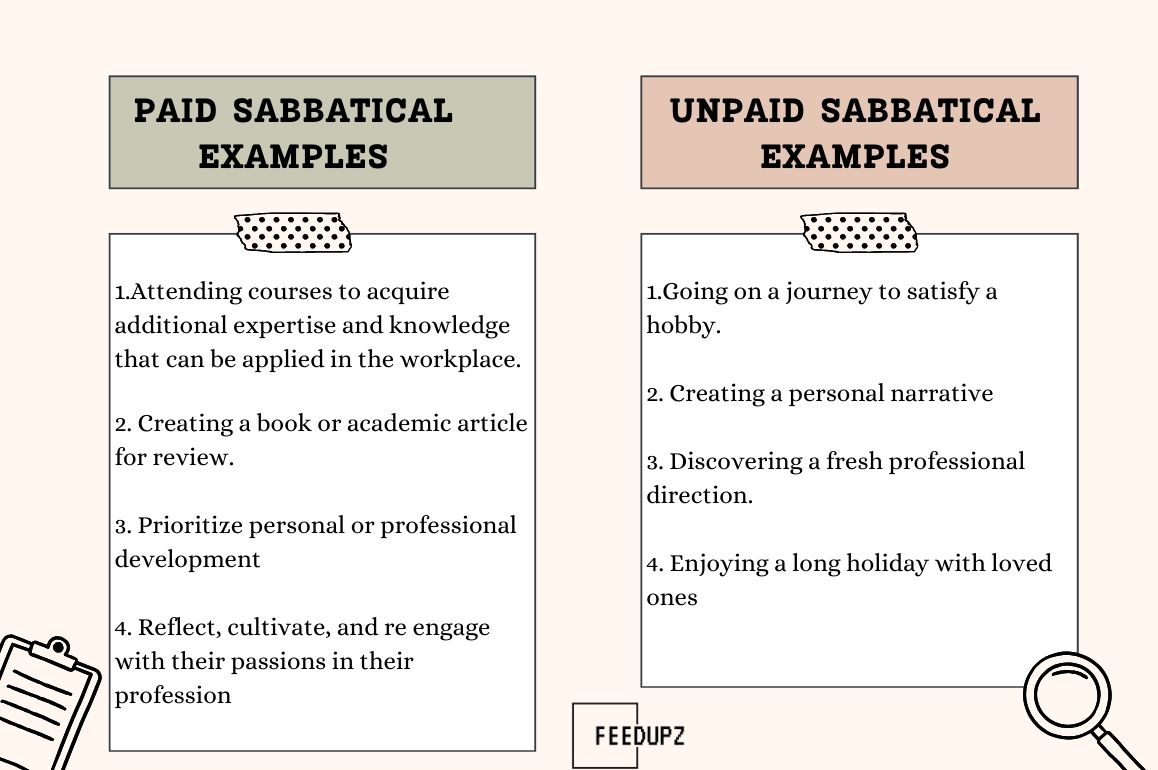Going on a sabbatical can have positive effects for both workers and companies. In this piece, we will examine the sabbatical in more detail. We will define sabbatical leave and explore the advantages of taking one. We will focus on the important aspects of a sabbatical leave policy and provide practical examples of sabbatical concepts and initiatives. Let’s go!
What is sabbatical leave from work?
A sabbatical is a time off work when an employee takes a long break. Motive for taking a sabbatical can range from obtaining a degree or focusing on a personal project to volunteering, exploring the globe, or dedicating more time to family.
A sabbatical differs from other leaves by being longer, typically lasting from a month to a year, and is typically only given to employees who have been with the company for a specified period of time. In this way, the sabbatical is seen as a form of employee benefit.
How does a sabbatical work?
Workers who are eligible for this leave typically have to request it many months ahead of time. Organizations will review the request and grant approval if it aligns with their criteria. Organizations must also plan to cover the duties of the employee on sabbatical by either finding a replacement or redistributing the workload to other staff members.
Most of the organizations have particular guidelines concerning sabbaticals. For instance, workers may be required to use their sabbatical within a certain time frame once they meet the requirements, or else it will be forfeited. Additionally, should an employee opt to utilize a sabbatical leave, they might be required to commit to remaining with the company for a set period upon their return, similar to tuition reimbursement benefits.
During a sabbatical, individuals remain as employees of the organization. This implies that they are still obligated to follow their organization’s regulations such as harassment, confidentiality, and data protection.
7 Benefits of Sabbatical Leave
Taking a sabbatical is advantageous for both the employee and their employer. Now, let’s begin by discussing the benefits of taking a sabbatical for employees:
- Less pressure: A research study with university professors found that those who took a sabbatical had reduced levels of stress when they returned to work.
- Increased psychological resources: The study also discovered an enhancement in psychological resources among individuals returning from a sabbatical, including improved health, feelings of control and independence, energy, and increased professional knowledge.
- Higher level of happiness: Not surprisingly, the mentioned factor resulted in a boost in the general happiness of individuals who took a longer break from their jobs, particularly if they utilized their time off in a different country.
Giving employees the opportunity to take a sabbatical also benefits employers:
- Improved wellness: The organization as a whole benefits from employees being healthy, as shown in the study indicating they remain healthy even after returning from their sabbatical. When individuals are in a positive mood, they are more inclined to positively influence their coworkers, have lower rates of absenteeism, and may also be more efficient.
- Succession planning stress test: A different study discovered that when executive leaders (within non-profit organizations) go on sabbatical, it serves as a beneficial assessment for the organization’s entire leadership.
While the top leaders are on break, emerging leaders have the opportunity to develop, assume new duties, and showcase their leadership abilities. Therefore, taking a sabbatical can offer a chance to evaluate and potentially make changes to your succession plan.
- Prepared for unforeseen absences: Relying on one or more team members too much is always a bad idea. Encouraging employees to take a sabbatical results in managers and teams making necessary arrangements for extended absences, ensuring seamless business operations in the event of someone’s departure.
- Employer Brand: Offering a ‘sabbatical option’ is a valuable benefit for both existing staff and potential hires. It demonstrates to others that you value your employees and appreciate their loyalty. While a sabbatical program may not be the primary factor in a candidate’s decision to work for a company, it can play a role in their decision-making process compared to other companies.
You may also like:
↘️ Home Depot Discounts for Employees
↘️ 9 Costco Employee Benefits and Perks
Are Sabbatical Leaves Paid, Unpaid, or Partially Paid?
One of the main concerns regarding sabbaticals is if they are compensated or not. Even when on a paid sabbatical, it is important to determine whether an employee will still get their full salary and perks, or a decreased sum. The decision of whether a sabbatical is paid or unpaid could be influenced by its duration and your financial resources. Failing to offer any form of compensation can prevent individuals with limited financial means from being able to take a sabbatical.
No matter how you choose to organize your policy, ensure it is clearly and consistently communicated and adheres to relevant wage and hour regulations at the local, state, and federal levels.
Examples of Paid vs. Unpaid Sabbatical Leave

How do you utilize sabbatical leaves?
While on a sabbatical, workers have the option to engage in different activities, including:
- Travel and Exploration: Many people take sabbaticals in order to travel, explore diverse cultures, and expand their horizons.
- Education and Skill Development: Some choose to take courses, workshops, or obtain certifications to improve their abilities or acquire knowledge in different areas, whether they are connected to their current job or not.
- Research and Writing: Academics or professionals in specific fields may utilize sabbaticals for conducting research projects or for writing books, articles, or papers.
- Volunteering or Social Causes: Engaging in activities such as volunteering or supporting social causes can provide a meaningful way to utilize a sabbatical.
- Rest and Rejuvenation: At times, the main purpose of a sabbatical is to rest, unwind, and temporarily escape from the pressures of everyday work.
Sabbatical leave policy – Key elements and template
How is a sabbatical leave policy structured? What guidelines must be followed for a sabbatical leave? The organization determines the specific meaning of a sabbatical policy, but we will provide some questions to include in your policy. We will provide a sabbatical leave policy template for you to download as well.
Let’s begin with the components that your policy should ideally include:
- Which individuals qualify for a sabbatical break? Some businesses aim to award their dedicated employees with a sabbatical leave. In that situation, individuals typically qualify for a sabbatical once they have completed a specific duration working for the organization.
- What is the duration of a sabbatical? Is it possible for individuals to have a three-month break? How about a year’s time? Is it influenced by the duration of time they have been employed by the company? What is the longest duration that employees can take for a sabbatical leave?
- Is the sabbatical compensated or uncompensated? This is likely to be influenced by financial constraints and the duration of the sabbatical. Some companies offer a percentage of salary during sabbatical, some provide full pay, and others offer no payment.
You may choose to make payment based on the purpose of someone’s sabbatical request. For example, if an employee wishes to pursue a master’s, PhD, or other degree for a year, you can view it as an investment in their growth and therefore, fund their costs.
Alternatively, it could be argued that taking a sabbatical is a way to invest in personal growth, regardless of how it is spent.
- What is the reason for taking a sabbatical? The majority of the time, employees take sabbatical leaves for reasons such as self-improvement or the chance to follow personal passions.
- What is the procedure? What is the process for employees to submit their applications? Is it necessary for them to compose a cover letter when replying to a job opportunity, or can they just utilize the organization’s time off request form? What is the amount of time needed to apply beforehand? Who is required to authorize the sabbatical absence? Answering all of these questions, along with others, is necessary in order to establish a well-organized system for managing sabbaticals within your company.
Using these components, we’ve developed a template for a sabbatical policy that is available for download. Please remember that this is merely a sample of how a simple policy could appear. The document does not consider any applicable local laws and regulations and is not a legally binding document.
Wrapping Up
Taking a sabbatical offers employees a special chance to engage in personal growth, skill improvement, or revitalization. Although details may differ between organizations, it typically includes a set time away from work responsibilities for individuals to engage in educational pursuits, travel, volunteer work, or personal projects.
Different companies offer different types of compensation for sabbatical leave, with some providing paid leave and others treating it as unpaid time off. In general, taking a sabbatical not only helps employees grow personally but also has the potential to improve their performance and impact when they come back to work.
FAQs
How long is a sabbatical?
The duration of a sabbatical from work depends on the institution or organization. Certain universities may offer a period of leave for either six months, a year (commonly referred to as a “sabbatical year”), or even longer.
Private corporations may provide employees with a sabbatical leave ranging from one month or more, which is determined by the company’s policies and the length of tenure of each individual employee. For instance, Adobe provides employees with four weeks of sabbatical after five years of employment and five weeks after 10 years of service.
Is sabbatical leave paid or unpaid?
Frequently, sabbatical leave is compensated, either with the entire salary or a portion of it – although unpaid sabbatical leave may be an option in some organizations.
Can Sabbatical Leave Benefit Employee Performance and Well-being?
A sabbatical leave provides a time for individual growth and renewal. The benefits gained from this time off typically have a positive impact on an employee’s overall health and work productivity when they come back to the office. Workers returning from a period of sabbatical could introduce fresh viewpoints, talents, and revitalized energy that could have a beneficial impact on the dynamics of the workplace.

